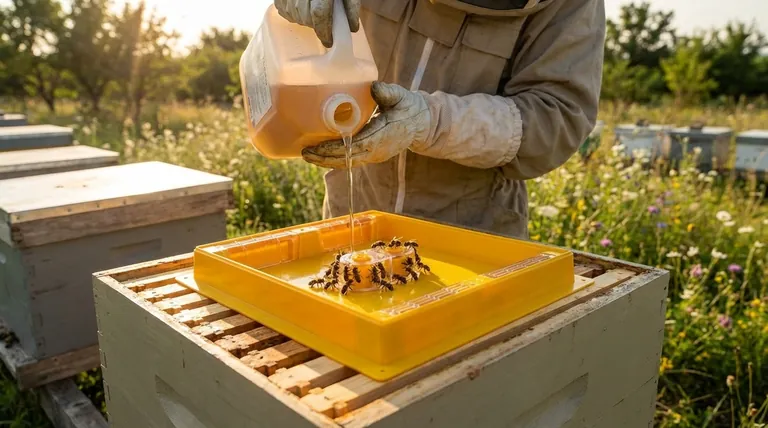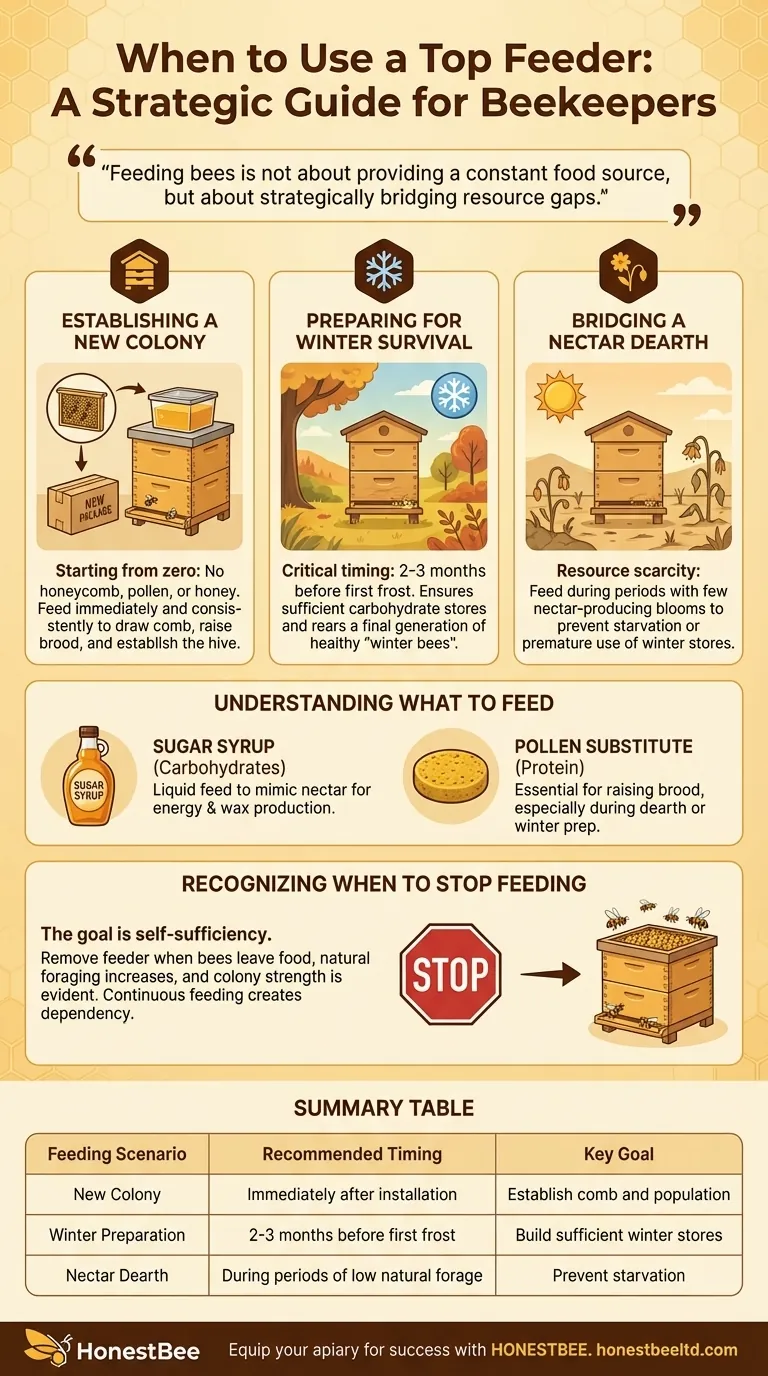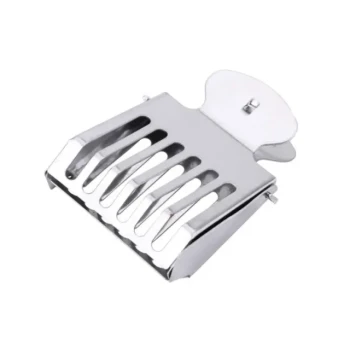The decision to use a top feeder is a critical intervention that should be reserved for specific periods of need. Beekeepers should feed bees when establishing a new colony, during a nectar shortage, or in the late summer and early fall (two to three months before the first frost) to ensure the colony has enough resources to survive the winter. This supplemental feeding helps a new colony establish itself or an existing one build the necessary strength and food stores when natural forage is scarce.
Feeding bees is not about providing a constant food source, but about strategically bridging resource gaps. The goal is to supplement nature only when necessary to ensure the colony's survival and strength, then allow it to become self-sufficient.

The Primary Reasons for Supplemental Feeding
Understanding why you are feeding is as important as knowing when. Feeding is an intentional management tool used to achieve specific outcomes for the colony's health.
Establishing a New Colony
A newly installed package of bees has no honeycomb, no stored pollen, and no stored honey. They are starting from zero.
Providing immediate and consistent food is the single most justified reason for feeding. It gives them the critical resources needed to draw out comb, begin raising brood, and establish a functional hive.
Preparing for Winter Survival
A colony's ability to survive winter is directly tied to its population size and the amount of honey it has stored.
Feeding a colony 2-3 months before the first expected frost ensures they have enough carbohydrates to rear a final generation of healthy "winter bees" and cap enough honey to last until spring.
Bridging a Nectar Dearth
A "dearth" is a period when few or no nectar-producing plants are in bloom. This can happen even in the middle of summer, causing a productive colony to suddenly face starvation.
Supplemental feeding during a dearth prevents the colony from consuming its winter stores prematurely or starving outright.
Understanding What to Feed
The type of feed you provide should align with the colony's nutritional needs. Bees require both carbohydrates (for energy) and protein (for raising young).
Sugar Syrup as a Honey Substitute
Modern beekeepers commonly use sugar syrup to mimic natural nectar and provide essential carbohydrates.
This is the "liquid feed" used in a top feeder to help bees produce wax, forage for resources, and store energy.
Pollen Substitutes for Brood Rearing
Sugar syrup alone is not enough. To raise new bees (brood), the colony needs protein, which they get from pollen.
During a dearth or when preparing for winter, pairing sugar syrup with a pollen substitute or patty provides the complete nutrition necessary for healthy colony growth and development.
Recognizing When to Stop Feeding
Continuous feeding creates dependency and can be detrimental. Knowing when to remove the feeder is a critical skill for any beekeeper.
The Goal is Self-Sufficiency
The primary objective is to have a strong, resilient colony that can sustain itself on natural forage. The feeder is a temporary bridge, not a permanent fixture.
Key Indicators to Watch For
You can confidently remove the feeder when you observe clear signs of self-sufficiency.
If the bees are leaving food in the feeder, natural foraging activity has visibly increased, and the colony is growing in strength, it is time to stop feeding.
The Risk of Continuous Feeding
Over-feeding can make a colony "lazy," discouraging them from seeking natural nectar sources. It can also attract pests like ants and wasps to the hive.
Most importantly, feeding while honey supers are on the hive risks contaminating your honey harvest with sugar syrup, which is unethical and defeats the purpose of producing pure honey.
Making the Right Choice for Your Colony
Your decision to feed should be based on the specific state and goal of your hive.
- If you are installing a new bee package: Feed immediately and consistently until they have drawn out several frames of comb and established strong, independent foraging patterns.
- If you are preparing an established colony for winter: Begin feeding a 2:1 sugar syrup (by weight) two to three months before the first frost, stopping once they have sufficient winter stores or stop taking the syrup.
- If you are managing a colony during a summer dearth: Provide a 1:1 sugar syrup only if you observe a lack of stored nectar and a drop in foraging activity, and remove it as soon as natural nectar sources return.
Ultimately, your greatest tool is careful observation, allowing you to intervene precisely when needed and foster a truly resilient colony.
Summary Table:
| Feeding Scenario | Recommended Timing | Key Goal |
|---|---|---|
| New Colony | Immediately after installation | Establish comb and population |
| Winter Preparation | 2-3 months before first frost | Build sufficient winter stores |
| Nectar Dearth | During periods of low natural forage | Prevent starvation |
Equip your apiary for success with HONESTBEE.
Strategic feeding is key to colony health, and having the right equipment makes all the difference. As a trusted supplier for commercial apiaries and distributors, HONESTBEE provides the durable, high-capacity top feeders and beekeeping supplies you need to manage your hives effectively.
Let us help you build stronger, more productive colonies. Contact our wholesale experts today to discuss your equipment needs and volume pricing.
Visual Guide

Related Products
- Professional Hive Top Bee Feeder for Beekeeping
- HONESTBEE Entrance Bee Feeder Professional Hive Nutrition Solution for Beekeeping
- Boardman Entrance Bee Feeder Durable Galvanized Steel and Wood Construction for Beekeeping
- Classic Boardman Entrance Bee Feeder Hive Front Feeding Solution
- HONESTBEE Professional Entrance Bee Feeder Hive Nutrition Solution
People Also Ask
- What types of hive boxes is the round hive top feeder compatible with? Universal Fit for 8 & 10-Frame Langstroth Hives
- Do I need an inner cover with a hive top feeder? Optimize Your Hive Setup for Healthy Bees
- Why is a top feeder essential for bees? Ensure Colony Health and Efficiency
- What is a top feeder for bees? Maximize Colony Health with Efficient Feeding
- What are the advantages of using top feeders for bees? Maximize Feeding Efficiency & Colony Safety



















